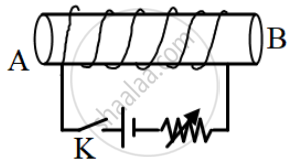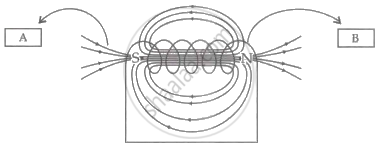Advertisements
Advertisements
Question
The figure shows a solenoid wound on a core of soft iron. Will the end A be a N pole or S pole when the current flows in the direction shown?

Solution
End A of the solenoid will be S pole because the direction of flow of current at this end is clockwise.
APPEARS IN
RELATED QUESTIONS
Why does a current carrying, freely suspended solenoid rest along a particular direction?
Draw a diagram to represent the magnetic field lines along the axis of a current carrying solenoid. Mark arrows to show the direction of current in the solenoid and the direction of magnetic field lines.
The factors on which one magnetic field strength is produced by current-carrying solenoids depends are
For a current in a long straight solenoid, N-pole and S-pole are created at the two ends. Among the following statements, the incorrect statement is ____________.
Under what conditions permanent electromagnet is obtained if a current carrying solenoid is used? Support your answer with the help of a labelled circuit diagram.
What does the divergence of magnetic field lines near the ends of a current carrying straight solenoid indicate?
The diagram below shows an insulated copper wire wound around a hollow cardboard cylindrical tube. Answer the questions that follow:

- What are the magnetic poles at A and B when the key K is closed?
- State two ways to increase the strength of the magnetic field in this coil without changing the coil.
- If we place a soft iron bar at the centre of the hollow cardboard and replace the DC source with an AC source then will it attract small iron pins toward itself when the current is flowing through the coil?
A circuit contains a battery, a variable resistor and a solenoid. The figure below shows the magnetic field pattern produced by the current in the solenoid.

- State how the magnetic field pattern indicates regions where the magnetic field is stronger.
- What happens to the magnetic field when the current in the circuit is reversed?
Ansari Sir was demonstrating an experiment in his class with the setup as shown in the figure below.

A magnet is attached to a spring. The magnet can go in and out of the stationary coil. He lifted the Magnet and released it to make it oscillate through the coil.
Based on your understanding of the phenomenon, answer the following question.
Is there any difference in the observations in the galvanometer when the Magnet swings in and then out of the stationary coil? Justify your answer.
Observe the given figure of a current-carrying solenoid and write the labels of A and B correctly.

